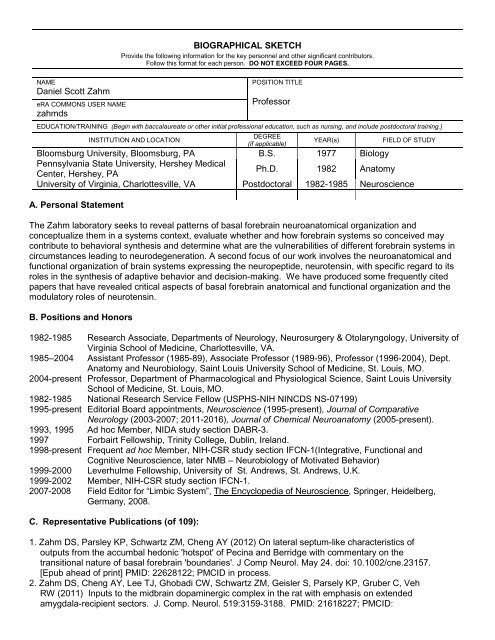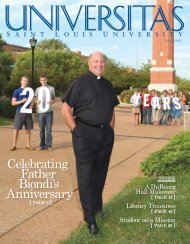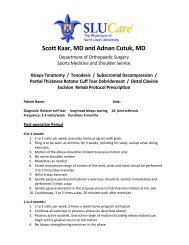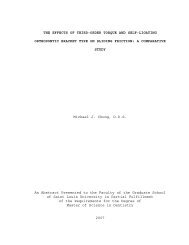You also want an ePaper? Increase the reach of your titles
YUMPU automatically turns print PDFs into web optimized ePapers that Google loves.
NAME<br />
Daniel Scott Zahm<br />
eRA COMMONS USER NAME<br />
zahmds<br />
BIOGRAPHICAL SKETCH<br />
Provide the following information for the key personnel and other significant contributors.<br />
Follow this format for each person. DO NOT EXCEED FOUR PAGES.<br />
POSITION TITLE<br />
Professor<br />
EDUCATION/TRAINING (Begin with baccalaureate or other initial professional education, such as nursing, and include postdoctoral training.)<br />
INSTITUTION AND LOCATION<br />
DEGREE<br />
(if applicable)<br />
YEAR(s) FIELD OF STUDY<br />
Bloomsburg <strong>University</strong>, Bloomsburg, PA B.S. 1977 Biology<br />
Pennsylvania State <strong>University</strong>, Hershey Medical<br />
Center, Hershey, PA<br />
Ph.D. 1982 Anatomy<br />
<strong>University</strong> of Virginia, Charlottesville, VA Postdoctoral 1982-1985 Neuroscience<br />
A. Personal Statement<br />
The Zahm laboratory seeks to reveal patterns of basal forebrain neuroanatomical organization and<br />
conceptualize them in a systems context, evaluate whether and how forebrain systems so conceived may<br />
contribute to behavioral synthesis and determine what are the vulnerabilities of different forebrain systems in<br />
circumstances leading to neurodegeneration. A second focus of our work involves the neuroanatomical and<br />
functional organization of brain systems expressing the neuropeptide, neurotensin, with specific regard to its<br />
roles in the synthesis of adaptive behavior and decision-making. We have produced some frequently cited<br />
papers that have revealed critical aspects of basal forebrain anatomical and functional organization and the<br />
modulatory roles of neurotensin.<br />
B. Positions and Honors<br />
1982-1985 Research Associate, Departments of Neurology, Neurosurgery & Otolaryngology, <strong>University</strong> of<br />
Virginia School of Medicine, Charlottesville, VA.<br />
1985–2004 Assistant Professor (1985-89), Associate Professor (1989-96), Professor (1996-2004), Dept.<br />
Anatomy and Neurobiology, <strong>Saint</strong> <strong>Louis</strong> <strong>University</strong> School of Medicine, St. <strong>Louis</strong>, MO.<br />
2004-present Professor, Department of Pharmacological and Physiological Science, <strong>Saint</strong> <strong>Louis</strong> <strong>University</strong><br />
School of Medicine, St. <strong>Louis</strong>, MO.<br />
1982-1985 National Research Service Fellow (USPHS-NIH NINCDS NS-07199)<br />
1995-present Editorial Board appointments, Neuroscience (1995-present), Journal of Comparative<br />
Neurology (2003-2007; 2011-2016), Journal of Chemical Neuroanatomy (2005-present).<br />
1993, 1995 Ad hoc Member, NIDA study section DABR-3.<br />
1997 Forbairt Fellowship, Trinity College, Dublin, Ireland.<br />
1998-present Frequent ad hoc Member, NIH-CSR study section IFCN-1(Integrative, Functional and<br />
Cognitive Neuroscience, later NMB – Neurobiology of Motivated Behavior)<br />
1999-2000 Leverhulme Fellowship, <strong>University</strong> of St. Andrews, St. Andrews, U.K.<br />
1999-2002 Member, NIH-CSR study section IFCN-1.<br />
2007-2008 Field Editor for “Limbic System”, The Encyclopedia of Neuroscience, Springer, Heidelberg,<br />
Germany, 2008.<br />
C. Representative Publications (of 109):<br />
1. Zahm DS, Parsley KP, Schwartz ZM, Cheng AY (2012) On lateral septum-like characteristics of<br />
outputs from the accumbal hedonic 'hotspot' of Pecina and Berridge with commentary on the<br />
transitional nature of basal forebrain 'boundaries'. J Comp Neurol. May 24. doi: 10.1002/cne.23157.<br />
[Epub ahead of print] PMID: 22628122; PMCID in process.<br />
2. Zahm DS, Cheng AY, Lee TJ, Ghobadi CW, Schwartz ZM, Geisler S, Parsely KP, Gruber C, Veh<br />
RW (2011) Inputs to the midbrain dopaminergic complex in the rat with emphasis on extended<br />
amygdala-recipient sectors. J. Comp. Neurol. 519:3159-3188. PMID: 21618227; PMCID:
PMC3174784.<br />
3. Lavezzi HN, Parsley KP, Zahm DS (2011) Mesopontine rostromedial tegmental nucleus neurons<br />
projecting to the dorsal raphe and pedunculopontine tegmental nucleus: psychostimulant-elicited<br />
Fos expression and collateralization. Brain Struct Funct. 217:719-734, 2012. [Epub ahead of print<br />
Dec 18]; PMID: 22179106; PMCID in process.<br />
4. Lavezzi HN, Zahm DS (2011) The mesopontine rostromedial tegmental nucleus: an integrative<br />
modulator of the reward system. Basal Ganglia 1:191-200. PMID: 22163100; PMCID in process.<br />
5. Zahm DS (2010) Pharmacological approach to the treatment of addiction: persisting challenges. Missouri<br />
Med, 107:276-280. PMID: 20806841; PMCID: PMC2964348<br />
6. Zahm DS, Becker ML, Freiman AJ, Strauch S, DeGarmo B, Geisler S, Meredith GE, Marinelli M (2010) Fos<br />
after single and repeated self-administration of cocaine and saline in the rat: emphasis on the basal<br />
forebrain and recalibration of expression. Neuropsychopharmacol 35:445-463, 2010. PMID: 19794406;<br />
PMCID: PMC2795057<br />
7. Jhou TC, Geisler S, Marinelli M, DeGrarmo BA, and Zahm DS (2009) The mesopontine rostromedial<br />
tegmental nucleus: A structure targeted by the lateral habenula that projects to the ventral tegmental area<br />
of Tsai and substantia nigra compacta. J Comp Neurol, 513:566-596. PMID: 19235216; PMCID:<br />
PMC3116663<br />
8. Zahm DS, and Trimble MR (2008) The dopaminergic projection system, basal forebrain macrosystems, and<br />
conditioned stimuli. CNS Spectrums 13:32-40. PMID: 18204412; PMCID: PMC3209755<br />
9. Geisler S, Marinelli M, DeGarmo B, Becker ML, Freiman AJ, Beales M, Meredith GE, and D.S. Zahm (2008)<br />
Prominent activation of brainstem and pallidal afferents of the ventral tegmental area by cocaine.<br />
Neuropsychopharmacol 33:2688-2700. PMID: 18094667; PMCID: PMC2978288.<br />
10. Geisler S, Derst C, Veh RW, and DS Zahm (2007) Glutamatergic afferents of the ventral tegmental area in<br />
the rat. J Neurosci 27:5730-5743. PMID: 17522317; PMCID; PMC3202987.<br />
11. Reynolds SM, Bérod A, Geisler S, and Zahm DS (2006) Modulation of a dopamine-mediated behavior by a<br />
neurotensin-containing pathway from the rostral basal forebrain to the ventral tegmental area. Eur J<br />
Neurosci 24:188-196. Free PMC article - PMID: 16882016<br />
12. Loopuijt LD and Zahm DS (2006) Synaptologic and fine structural features distinguishing a subset of basal<br />
forebrain cholinergic neurons embedded in the dense intrinsic fiber network of the caudal extended<br />
amygdala J Comp Neurol 498:93-111. Free PMC article - PMID: 16933208<br />
13. Reynolds SM, and Zahm DS (2005) Macrosystem-specificity of projections from prefrontal and insular<br />
cortex to ventral striatopallidum and extended amygdala. J Neurosci 25:11757-11767.<br />
14. Zahm DS. (2006) The evolving theory of basal forebrain “functional-anatomical macrosystems”. Neurosci<br />
Biobehav Rev 30:148-172.<br />
15. Geisler S, Zahm DS. (2005) Afferents of the ventral tegmental area in the rat - anatomical substratum for<br />
integrative function. J Comp Neurol 490:270-294.<br />
D. Research Projects Ongoing or Completed During the Last 3 Years:<br />
On-going:<br />
R01 NIH NS023805 D.S. Zahm (PI) 12/01/2007 - 12/31/2012<br />
NIH/NINDS<br />
Convergent vs. Parallel Striatal Dopaminergic Afferents<br />
Because the mesocorticolimbic system is essential to the detection of novelty, primary rewards, rewardpredicting<br />
stimuli and the enlistment of appropriate adaptive behavioral responses, and because the septalpreoptic<br />
system projects robustly to the neurons of origin of the mesocorticolimbic system in the VTA, it seems<br />
likely that the actions of the septal-preoptic system, mediated at least in part by neurotensin acting in the VTA,<br />
are involved in mechanisms brought to bear to weigh threat and gain in the consideration of potential actions. In<br />
view of these considerations, the following specific aims were stated: 1. Establish neuroanatomical<br />
relationships of the lateral septum and lateral preoptic-rostral lateral hypothalamic region (LPH); 2. Investigate<br />
behavioral correlates of activating and inactivating the lateral septum and LPH; 3. Determine if activation of<br />
LPH produces internalization of NTS1 (neurotensin) receptors within dopaminergic neurons in the VTA.<br />
Maladaptive decision-making in humans coexists with anxiety, depression, fear, panic and obsessioncompulsion.<br />
At a subclinical, social level, bad decisions pervade chronic joblessness, dysfunctional<br />
interpersonal relationships, ruinous child-rearing and addictions. Indeed, addiction is bad decision-making by
definition, i.e., behavior compulsively repeated in the certain knowledge of its self-destructiveness. This<br />
research will address the structural and functional organization of an important, but poorly understood,<br />
component of the brain systems that subserve decision-making.

















